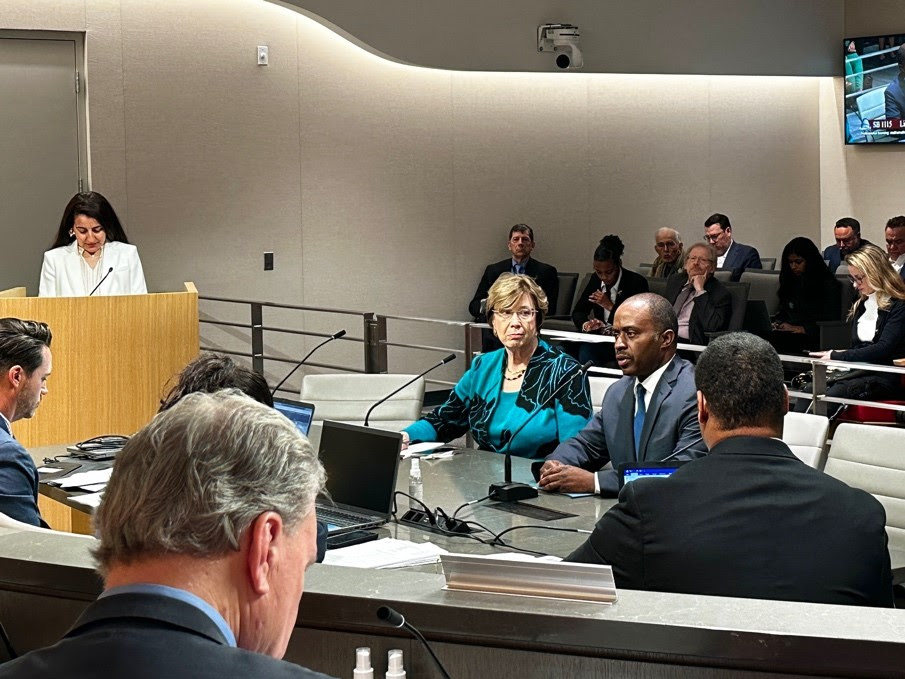State Superintendent Makes Historic Push for Results-Proven Training in Literacy, Math as Sponsor of SB 1115 – SCVNews.com
State Superintendent Makes Historic Push for Results-Proven Training in Literacy, Math as Sponsor of SB 1115 SCVNEWS.com


State Superintendent of Public Instruction Testifies on the Need for Results-Proven Training for Teachers

State Superintendent of Public Instruction Tony Thurmond testified today in the Senate Education Committee about the need for results-proven training for all teachers of reading and math.
Supporting Senate Bill 1115 to Improve Student Outcomes
Thurmond’s testimony was in support of Senate Bill 1115, which proposes to fund evidence-backed educator training in order to address the urgent need for improved student outcomes across the state. The committee passed the bill after Thurmond’s testimony, and the bill now goes to the Senate Appropriations Committee on May 6.
Addressing the Training Gap
Current efforts to fund educator training in literacy and math are only sufficient to train one-third of California’s educator workforce. SB 1115 would fund the remaining two-thirds.
Emphasizing the Importance of Equitable Education
“This is an issue of moral clarity,” said Thurmond. “In the fifth-largest economy in the world, and in an age when we have access to substantial brain science about how students learn, it should be unacceptable to train only some educators in the best strategies to teach essential skills.”
Incorporating Research-Backed Methods
The idea of “brain science” behind literacy instruction has been at the center of fierce debate in recent years, and the phrase “science of reading” has become both a polarizing term and galvanizing cry. SB 1115 includes support for multiple methods backed by research, including phonics, as well as language development strategies aligned to the California ELA/ELD Framework proven to support and encourage biliteracy and multilingualism.
Ensuring Early Literacy for All Children
“Every child should feel supported as they learn to read and every teacher should feel confident in their ability to support students’ foundational literacy,” said Thurmond. “SB 1115 is about ensuring that all children have the opportunity to read by third grade, and that all children have a shot at the life-changing outcomes that come from early literacy.”
Addressing the Impact of Illiteracy
According to the National Assessment of Adult Literacy, 70 percent of incarcerated adults are estimated to be struggling readers or illiterate.
Contact Information
Anyone wishing to learn more about Thurmond’s literacy efforts in California and his goal to ensure that students learn to read by third grade may email statewideliteracycampaign@cde.ca.gov.
Related
SDGs, Targets, and Indicators in the Article
1. Which SDGs are addressed or connected to the issues highlighted in the article?
- SDG 4: Quality Education
The article discusses the need for improved student outcomes and the importance of training teachers in reading and math. This aligns with SDG 4, which aims to ensure inclusive and equitable quality education and promote lifelong learning opportunities for all.
2. What specific targets under those SDGs can be identified based on the article’s content?
- Target 4.1: By 2030, ensure that all girls and boys complete free, equitable, and quality primary and secondary education leading to relevant and effective learning outcomes.
- Target 4.5: By 2030, eliminate gender disparities in education and ensure equal access to all levels of education and vocational training for the vulnerable, including persons with disabilities, indigenous peoples, and children in vulnerable situations.
The article emphasizes the need for improved student outcomes and mentions the goal of ensuring that all children have the opportunity to read by third grade. These targets align with the objective of providing quality education and equal access to learning opportunities for all students.
3. Are there any indicators mentioned or implied in the article that can be used to measure progress towards the identified targets?
- Indicator 4.1.1: Proportion of children and young people (a) in grades 2/3; (b) at the end of primary; and (c) at the end of lower secondary achieving at least a minimum proficiency level in (i) reading and (ii) mathematics, by sex.
- Indicator 4.5.1: Parity indices (female/male, rural/urban, bottom/top wealth quintile, and others such as disability status, indigenous peoples, etc.) for all education indicators on this list that can be disaggregated.
The article highlights the need for improved student outcomes in reading and math, which can be measured by assessing the proportion of children achieving at least a minimum proficiency level in these subjects. Additionally, the article mentions the importance of ensuring equal access to education, which can be measured using parity indices to assess gender disparities and disparities among different socio-economic groups.
SDGs, Targets, and Indicators Table
| SDGs | Targets | Indicators |
|---|---|---|
| SDG 4: Quality Education | Target 4.1: By 2030, ensure that all girls and boys complete free, equitable, and quality primary and secondary education leading to relevant and effective learning outcomes. | Indicator 4.1.1: Proportion of children and young people (a) in grades 2/3; (b) at the end of primary; and (c) at the end of lower secondary achieving at least a minimum proficiency level in (i) reading and (ii) mathematics, by sex. |
| SDG 4: Quality Education | Target 4.5: By 2030, eliminate gender disparities in education and ensure equal access to all levels of education and vocational training for the vulnerable, including persons with disabilities, indigenous peoples, and children in vulnerable situations. | Indicator 4.5.1: Parity indices (female/male, rural/urban, bottom/top wealth quintile, and others such as disability status, indigenous peoples, etc.) for all education indicators on this list that can be disaggregated. |
Behold! This splendid article springs forth from the wellspring of knowledge, shaped by a wondrous proprietary AI technology that delved into a vast ocean of data, illuminating the path towards the Sustainable Development Goals. Remember that all rights are reserved by SDG Investors LLC, empowering us to champion progress together.
Source: scvnews.com

Join us, as fellow seekers of change, on a transformative journey at https://sdgtalks.ai/welcome, where you can become a member and actively contribute to shaping a brighter future.







